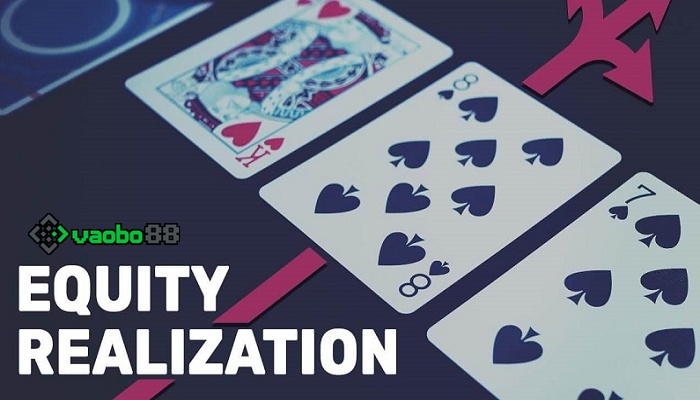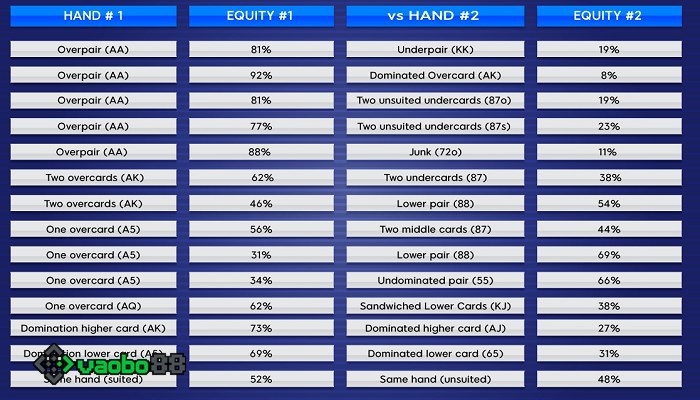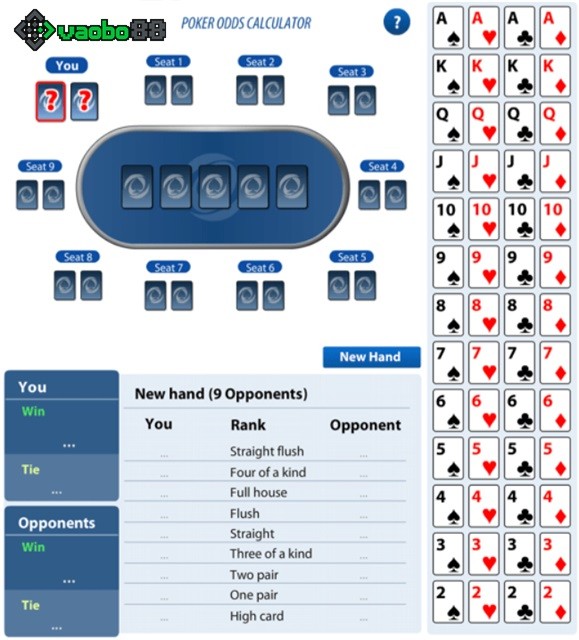What factors determine whether you will bet, raise, call, or fold in Poker? Is it based on intuition or the method of calculating Equity in Poker?
If you are still betting in a “let’s see what happens” manner, then the content below is exactly what you need to avoid regretting later.
What is Equity in Poker?
Equity in Poker is a Poker term defined as the winning percentage of a player at a specific moment in time.
To be precise, it is the winning percentage at each round of play such as Pre-Flop, Flop, Turn, and River.
Many people also define it as the percentage of the total money you can own from the pot at a specific moment.
If you have a hand with a 70% chance of winning, then your Poker Equity is 70%, calculated at that moment.

The method of calculating Equity in Poker is based on mathematical formulas, calculating outs and the likelihood of drawing cards to determine how much % winning chance a player has.
Example: In a game, A holds A of hearts – K of hearts and B holds J of spades – 10 of clubs in the Preflop round. Based on the outs, A will have a 65% chance of winning, thus A’s Equity reaches 65%.
The Equity rule in Poker calculates the winning percentage of all hands present on the table, and the total Equity of all players must equal exactly 100%.
See more: What is EV Poker?
How to calculate Expected Value Poker according to international law.
Does the Equity percentage change?
The Equity percentage will change with each round of play. The rule of Poker is that with each betting round, community cards will be revealed.
Therefore, the connections between the two hole cards and the five community cards will continuously change, and thus the winning chances of the players will also change, meaning the Equity will change as well.
With the following two examples, you will understand this clearly!
a) Example 1:
Suppose in the PreFlop round, A holds K ♥️ – K ♦️ and B holds 2 ♣️ – 3 ♠️.
A’s Equity at the first round will be extremely high at over 90%, while B’s is less than 10%.
However, if in the Flop round, three 2s are revealed, then B’s Equity will be 96%, while A’s Equity drops to only 4%.
This is an example of the change in Equity from round 1 to round 2.

b) Example 2:
A holds A ♦️ – K ♦️, B holds 10 ♥️ – 9 ♦️.
- Preflop round: A has an Equity of 65%, B has 35%.
- In the Flop round, three community cards are revealed: 10 of diamonds – 9 of hearts and K of hearts. At that point, A’s Equity drops to 22% while B’s rises to 78%.
- If the Turn reveals the fourth card as A, then A’s winning percentage increases back to 60%.
Through the two examples above, you will see very clearly that Equity in Poker is not a constant; it will fluctuate, increasing or decreasing according to the cards that appear on the table or, more precisely, through each round.
This also indicates to you how much the chance of winning is at a certain moment in the hand, not for each hand.
How is Equity calculated in Poker?
According to the above concept, when simulating a situation in the Preflop round, you must calculate in the Flop, Turn, and River rounds.
If in the Flop, you must simulate all possible outcomes in the Turn and River.
As we know, there are up to 1.7 million different combinations, so the first assertion is that it is impossible to statistically analyze and calculate manually to simulate each case.
Equity in Poker is calculated from simulation software installed on computers.

These software programs will simulate and calculate all possible outcomes of the hands and provide the most accurate Equity number.
Specifically, when you input data about the hands, this system will automatically run. It will present all hypothetical situations about the remaining cards, recording the win-loss ratio with each specific variable.
Finally, it will return the Equity of each hand at that moment, and we will have the number we need.
Application of Equity in each betting round
Knowing your winning probability is what percentage, the first thing that players do is base their decisions on whether to Bet – Call or Fold.
Thus, it both increases the chance of winning and minimizes risk to the maximum.
However, as mentioned above, you must know all the cards of your opponents and have a simulation software like EQUILAB to assist in calculations; you cannot calculate manually.
Therefore, it can be asserted that immediately at the table, Equity has almost no effect.
But if it has no effect, then surely it would not be revered by so many bettors.
While the exact method of calculating Equity in Poker cannot be done, there are still tricks to calculate Equity relatively.
This formula requires you to understand what Outs in Poker are – that is the probability of waiting for the Poker hand.
Once you have the number of Outs, you can calculate the relative Equity of each round as follows:
- If you are at Flop: Take the number of Outs x 4 and add the % sign. For example, if at Flop you have 9 outs ⇒ your relative Equity is 9×4=36%.
- If at the Turn round: Number of Outs x 2 and add the % sign.
However, it will be very difficult to calculate the number of outs in the Preflop round because there are still too many combinations, so if you hold a high card or a pair in your hole cards, betting strongly in the Preflop round to eliminate opponents is the safest.
When moving to the next 2 rounds, you need to be careful again because the community cards have been revealed, and the Equity of the hands has changed significantly.
Conclusion
What is Equity and how to calculate Equity in Poker has been answered very clearly and understandably.
Hopefully, this will be useful information for you to increase your chances of winning when betting at reputable Poker games as well as to achieve greater success in the green bet rounds.








